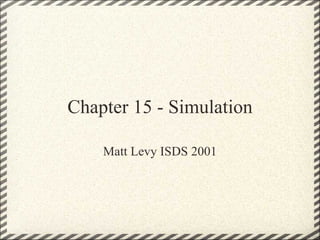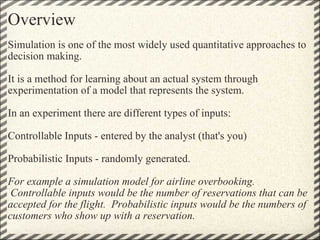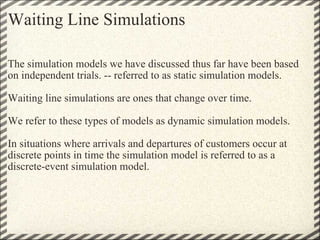Chapter 15R Lecture
- 1. Chapter 15 - Simulation Matt Levy ISDS 2001
- 2. Overview   Simulation is one of the most widely used quantitative approaches to decision making. It is a method for learning about an actual system through experimentation of a model that represents the system. In an experiment there are different types of inputs: Controllable Inputs - entered by the analyst (that's you) Probabilistic Inputs - randomly generated. For example a simulation model for airline overbooking.  Controllable inputs would be the number of reservations that can be accepted for the flight.  Probabilistic inputs would be the numbers of customers who show up with a reservation.
- 3. Risk Analysis The process of predicting the outcome of a decision in the face of uncertainty. One approach to risk analysis is a what if analysis A what-if analysis provides us with a base case, worst case, and best case scenario. While a what-if analysis gives us some information about our profit range, it tells us nothing about the probability of a specific profit. So we use this only in limited scenarios. Let's look at a quick example...
- 4. Risk Analysis Selling Price = $249 per unit. Administrative cost = $400000 Advertising Cost = $600000 These are the model parameters.  Direct Labor (c1), cost of parts (c2), and first year demand (x) are the prob. inputs. Thus our Profit Model is:  Profit = ($249 - c1 - c2)x - 1000000 PortaCom's best estimate is 45, 90, and 15000 for c1, c2, and x respectively. PortaCom's also realizes things could range from 43 to 47 for labor, 80 to 100 per unit, and 1500 to 28,500 for demand. Thus plugging in the high and low points of those figures, we get: Base Case:  710000 Best Case: 2,591,000 Worst Case: -847,000 Â
- 5. Simulation Using the profit model generated from the what-if analysis we can generate simulated data.    Profit = ($249 - c1 - c2)x - 1000000 Required is that we know the probability distribution for each probabilistic input. This way numbers that have a higher probability of occurring will happen in that range more frequently. Once we have the distributions, we can use Excel to generate random numbers and values for the profit model. For example:  =NORMINV( Rand() , Mean , StandardDeviation )
- 6. Waiting Line Simulations The simulation models we have discussed thus far have been based on independent trials. -- referred to as static simulation models. Waiting line simulations are ones that change over time. We refer to these types of models as dynamic simulation models. In situations where arrivals and departures of customers occur at discrete points in time the simulation model is referred to as a discrete-event simulation model.
- 7. The End Problems: 1-10. Read the Chapter as it is mostly example driven.






